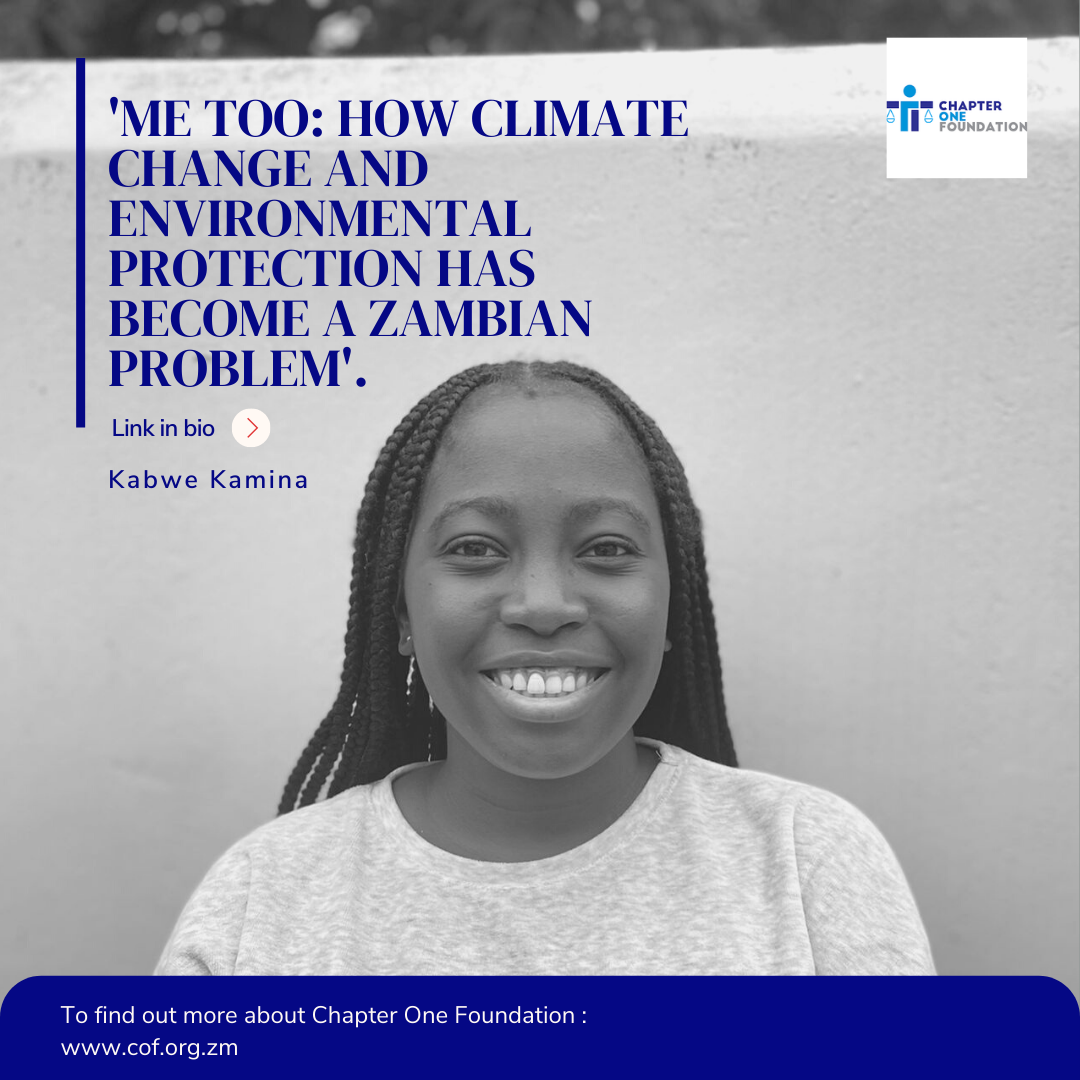
- January 25, 2022
- Chapter_One_Foundation
- 0
The climate change conversation has taken different shapes and tones over the last decade. In the beginning, Zambians seemed uninterested in the hysteria behind global warming and the rising coastlines across the world. After all, why would a landlocked country have to worry about the sea levels rising or icebergs melting? But as time has gone by, climate change has begun to greatly affect Zambia and the biggest question now is, what do we do?
Around September 2014, the country began to experience scheduled and prolonged power outages. The national electricity company stated that this was due to low water levels in Lake Kariba which hosts the Kariba Power Station that, at the time, was responsible for majority electric supply in the country. The power outages led to a dependence on charcoal which meant that more trees were cut to keep up with the demand. By 2018, Zambia had dropped to about 28.4% tree cover from 30% in 2010. To give an idea of how devastating this could be, in 2020, Zambia lost an estimated 163,000 hectares of tree cover to deforestation and this was equivalent to 59.7 metric tons of carbon dioxide emission. From 2000 to 2020, Zambia has lost about 1.87 million hectares of tree coverage which is equivalent to 690 metric tons of carbon dioxide emission. To put all the data into perspective, carbon dioxide is part of a group of gasses called ‘greenhouse gases. The main function of these gasses is to absorb heat and release it gradually. Without the effects of greenhouse gasses, the earth’s temperature would be too low to sustain life. However, in the reverse, the more greenhouse gasses accumulate in the atmosphere, the more heat is trapped in the atmosphere, eventually raising the earth’s temperature.
What naturally followed from the extreme deforestation was seasons of drought and power outages. The drought experienced between 2018 and 2019 alone left the country facing serious food insecurity. In addition to prolonged periods without rain, other parts of the country have begun to experience above normal rainfall. Stories of flash floods and ruined crops, rockslides, and submerged bridges have become more common. The farming season has shifted tremendously and without warning and in most years, farmers are often unprepared for the late start to the rainy season.
There is no telling the devastation that awaits vulnerable individuals at the hands of unaddressed climate issues. Many communities are facing hunger, destruction from unprecedented droughts or floods and strains of diseases that are resistant to medicine. In addition, destroyed communities will eventually cause a migrant problem as that places that remain habitable will be overwhelmed by the number of people seeking refuge from their destroyed communities.
Climate change is clearly a multi-sectoral issue that needs to be tackled on all levels. For example, families would not need to depend on cutting trees to create income by selling charcoal and also to cook and warm themselves if they were given alternative and sustainable energy resources. However, sustainability is often seen as a foreign and expensive undertaking that is beyond the limited resources that many people in Zambia have access to. In addition, authorities responsible for the development of sustainable systems that mitigate the adverse effects of climate change are either underfunded, understaffed, or non-existent. The need for government backing and support in promoting sustainable climate practices cannot be overemphasized.
Zimbabwe is an example of an African government that has successfully supported sustainable energy sources. The Forestry Act, Chapter 19:05 of the Laws of Zimbabwe directly provides for the protection and reservation of Zimbabwe’s forests. The existence of this law made it easier to pass the Forest (Control of Firewood, Timber and Forest Produce) Regulations of 2012 which, in Section 3(1), effectively banned the production of charcoal. Furthermore, because of the existence of such law, the Zimbabwean government was able to collaborate with Environmental Activists (to be specific, the Zimbabwe Environmental Lawyers Association (ZELA)) in effectively banning the mining of coal within national parks to protect wildlife and natural resources. The role that positive and direct legislation could play in the protection of Zambia’s natural resources is immense. While lobbying and petitions may go so far, protective laws prevent the possible development of harmful practices and underground industries such as deforestation for the sake of commercial farming or for the sake of commercial charcoal production.
In April 2016, The National Policy on Climate Change was released by the Ministry of National Development and Planning. It provided a situational analysis for the climate related issues that the country was facing at the time, some of which still persist. The vision of the policy was to build a prosperous and climate-resilient economy by 2030. This was to be achieved through measures focused on adaptation and risk reduction, mitigation, and low emission development actions, and taking measures to cross-cutting issues such as gender, low-income households. Mandates were given to different ministries and a structure for implementation was created.
However, since the publication of the policy on climate change, major implementations were only implemented in early 2021, the biggest of which was the launches of the National Climate Change Learning Strategy in March and the National Adaptation Planning for Climate Resilience (NAP4CR) Project in April. While these were steps in the right direction, there is no hiding that more needs to be done. With the launch of the Ministry of Green Economy and the Environment, we can only hope that environmental sustainability is truly prioritized in the years to come. Zambia already boasts the formidable National Policy that provides excellent guidance on the drafting of good legislation. We just have to utilize it!
Alternative fuel and energy sources have been innovated throughout the years and the options are now nearly endless and equally as inexpensive. For example, the My Climate Project based in multiple provinces in China that’s encouraging the use of corn husks as an alternative to coal. This is especially efficient as corn is a major export of these regions and thus an inexpensive and sustainable source of energy. Zambia has already proved to be formidable in coming up with sustainable solutions from the invention of the Ziko Stove, an mbaula that uses almost half the amount of charcoal that a traditional mbaula would use, combining this with using corn husks would be a great innovation. Furthermore, we could take a page out of Singapore’s book and incinerate the piling waste while building more sustainable waste management solutions. There is hope as we find ourselves in the golden hour of sustainable development and in a great position to adopt sustainable environmental practices to secure a bright future for Zambia. We therefore encourage the government to take a good look into the vast array of solutions that are sitting in our rich resources.
At the 2021 COP26 Summit, President Hakainde Hichilema insisted on the need for collaboration in order to secure our mutual safety and success. With all the work that needs to be done, a collaborative effort is needed from all stakeholders and members of society. While 1.5 degrees Celsius may seem like a tiny amount for temperature increase, we are already seeing the devastating effects. Let us band together to move towards building sustainable climate solutions.

